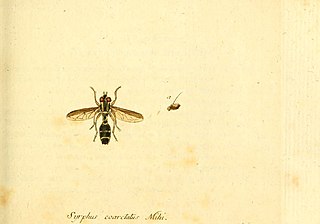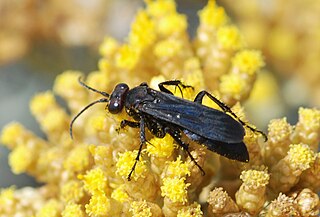
Hoverflies, also called flower flies or syrphids, make up the insect family Syrphidae. As their common name suggests, they are often seen hovering or nectaring at flowers; the adults of many species feed mainly on nectar and pollen, while the larvae (maggots) eat a wide range of foods. In some species, the larvae are saprotrophs, eating decaying plant and animal matter in the soil or in ponds and streams. In other species, the larvae are insectivores and prey on aphids, thrips, and other plant-sucking insects.

The family Agaonidae is a group of pollinating and nonpollinating fig wasps. They spend their larval stage inside the fruits of figs. The pollinating wasps are the mutualistic partners of the fig trees. The non-pollinating fig wasps are parasitoids. Extinct forms from the Eocene and Miocene are nearly identical to modern forms, suggesting that the niche has been stable over geologic time.

Sceliphron, also known as black mud daubers or black mud-dauber wasps, is a genus of Hymenoptera of the Sphecidae family of wasps. They are solitary mud daubers and build nests made of mud. Nests are frequently constructed in shaded niches, often just inside of windows or vent openings, and it may take a female only a day to construct a cell requiring dozens of trips carrying mud. Females will add new cells one by one to the nest after each cell is provisioned. They provision these nests with spiders, such as crab spiders, orb-weaver spiders and jumping spiders in particular, as food for the developing larvae. Each mud cell contains one egg and is provided with several prey items. Females of some species lay a modest average of 15 eggs over their whole lifespan. Various parasites attack these nests, including several species of cuckoo wasps, primarily by sneaking into the nest while the resident mud dauber is out foraging.

Volucella pellucens, the pellucid fly, is a hoverfly.

The Brachyceran infraorder Xylophagomorpha is a small group that consists solely of the family Xylophagidae, which presently contains subfamilies that were sometimes considered to be two small related families. Other obsolete names for members of this family include Exeretonevridae and Heterostomidae.

Episyrphus balteatus, sometimes called the marmalade hoverfly, is a relatively small hoverfly (9–12 mm) of the Syrphidae family, widespread throughout the Palaearctic region, which covers Europe, North Asia, and North Africa. It is considered the most abundant native hoverfly in Central Europe.

Eristalinae are one of the four subfamilies of the fly family Syrphidae, or hoverflies. A well-known species included in this subfamily is the dronefly, Eristalis tenax.

A wasp is any insect of the narrow-waisted suborder Apocrita of the order Hymenoptera which is neither a bee nor an ant; this excludes the broad-waisted sawflies (Symphyta), which look somewhat like wasps, but are in a separate suborder. The wasps do not constitute a clade, a complete natural group with a single ancestor, as bees and ants are deeply nested within the wasps, having evolved from wasp ancestors. Wasps that are members of the clade Aculeata can sting their prey.

Ceriana vespiformis is a species of hoverfly. It is a typical wasp mimic, is 10–11 mm long, and has very long antennae for a hoverfly.

Ceriana is a genus of hoverfly. All species are wasp mimics.

Cerioidini is a widespread tribe of around 222 species of hoverfly. Cerioidini are mistaken for wasps for which they are effective mimic. Cerioidini have antennae with a terminal style and have somewhat elongate and basally constricted abdomens, only slightly in Ceriana, but pronounced in most Sphiximorpha; and Polybiomyia, and extremely in Monoceromyia. Larvae live mostly within tree sap associated with tree wounds or putrefying pockets of water in tree cavities.

The Milesiini is a large and diverse tribe of hoverflies. They mimic wasps or hornets.

Milesia is a genus of very large hoverflies, which mimic social wasps. For example, the European species Milesia crabroniformis is a convincing mimic of the hornet species Vespa crabro. Milesia are predominantly Palaeotropical in distribution almost entirely Oriental.

Doros profuges is a Palearctic species of hoverfly.

Agenioideus is a genus of spider wasps from the subfamily Pompilinae; the genus occurs in Europe, where 21 species are recorded, eastwards to Japan, in North America, South America, and Australia.

Ceriana abbreviata , the Northern Wasp Fly , is a rare species of syrphid fly observed across North America and Canada. Hoverflies can remain nearly motionless in flight. The adults are also known as flower flies for they are commonly found on flowers, from which they get both energy-giving nectar and protein-rich pollen. The adults are wasp mimics. The larvae feed on the sap of tree wounds.

The Randecker Maar Research Station is a bird observatory which was founded in 1969 by the ornithologist Wulf Gatter. It studies birds, insects and other migratory creatures which tend to concentrate in the pass through the crater of the Randecker Maar as they fly over the Swabian Jura.
Deineches is a genus of hoverflies from the family Syrphidae, in the order Diptera.
Deineches nudiventris is a species of hoverfly in the family Syrphidae.

Mesembrina mystacea is a fly belonging to the family Muscidae.
















